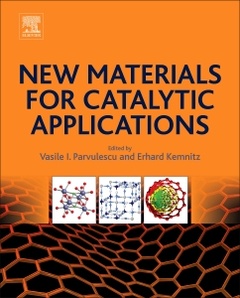New Materials for Catalytic Applications

New Materials for Catalytic Applications proposes the use of both new and existing materials for catalytic applications, such as zeolites, metal oxides, microporous and mesoporous materials, and monocrystals. In addition, metal-oxides are discussed from a new perspective, i.e. nano- and photocatalytic applications.
The material presents these concepts with a new focus on strategies in synthesis, synthesis based on a rational design, the correlation between basic properties/potential applications, and new catalytic solutions for acid-base, redox, hydrogenation, photocatalytic reactions, etc.
New materials for catalytic applications
1. Double metal cyanides as heterogeneous catalysts for organic reactions
Dirk De Vos
2. MOFs as catalysts of organic reactions
Hermenegildo Garcia
3. On the use of organometallic concepts for the synthesis of nanocatalysts
Karine Philippot
4. Catalysts on metallic surfaces: monoliths and microreactors
Miguel Ángel Centeno
5. Metal Oxide Nanostructures and Their Development and Perspective in Photoreduction of Carbon Dioxide to Fuel
Ryan Richards
6. Nano-metal fluorides in heterogeneous catalysis
Erhard Kemnitz
7. Metal oxides and fluorinated metal oxides as heterogeneous catalysts for use with Chloro- and Fluoro-carbons
David Lennon and John Michael Winfield
8. Mesoporous materials incorporating metal triflates
Pedro Amoros
9. Nitrogen-doped carbon composites as metal-free for catalysis
Cuong Pham-Huu
10. Metal sulphides: novel synthesis methods and recent developments in hydrotreatment and photocatalysis
Gilles Daniel Berhault
Academics researching catalytic phenomena, materials scientists, industrial researchers working with solid state materials to invent new chemical, industrial development scientists
Vasile I. Parvulescu is Founder and director of the Catalysts and Catalytic Processes Research Center in Romania and Professor at Bucharest University, he is an internationally well-known expert in catalysts and catalytic processes, particularly for environmental protection and green chemistry. He was an "Alexander von Humboldt" fellowship in 1997 and a visiting professor at several educational institutions worldwide. He is a member of the SUNERGY/SUNER-C Board and of several Permanent International Conferences and catalysis associations. He made many plenary and keynote lectures worldwide. He authorises several books, over 400 publications, and various patents.
Professor Kemnitz studied chemistry at the Humboldt-Universität zu Berlin (Germany) and finished it in 1973 with the diploma degree. In 1977 he received his doctoral degree at Humboldt-Universität zu Berlin under the supervision of Dieter Hass with a thesis on kinetics and mechanism of solid-gas reactions. He was acquiring a Humboldt award for this thesis in 1978. After being for one year a lecturer for Chemical Engineers he returned to the Humboldt-Universität and finished his Habilitation 1986 on heterogeneous chlorine/fluorine exchange reactions. In 1988 he became an assistant professor and received a full-time tenure track in 1994, both at the Humboldt-Universität zu Berlin. He was head of the Chemistry Department of Humboldt-University from 2001 until 2004. He is member of the editorial board of the Journal of Fluorine Chemistry. His main research interests cover the synthesis and characterisation of strongly distorted nanoscopic metal fluorides for applications in the field of heterogeneous catalysis, optics, ceramics, surface coating etc. He published about 400 papers, 9 review articles, 10 books and/or book chapters, and filed 12 patents. In 2010 he founded the “nanofluor GmbH.
- Presents organometallic concepts for the synthesis of nanocatalysts
- Provides a synthesis of new materials following the fluorolytic sol-gel concept
- Covers electronic and photocatalytic properties via synthesis of nano-oxide materials
- Details the nature of sites in MOFs generating catalytic properties immobilization of triflates in solid matrices for organic reactions
Date de parution : 01-2016
Ouvrage de 386 p.
19x23.3 cm



